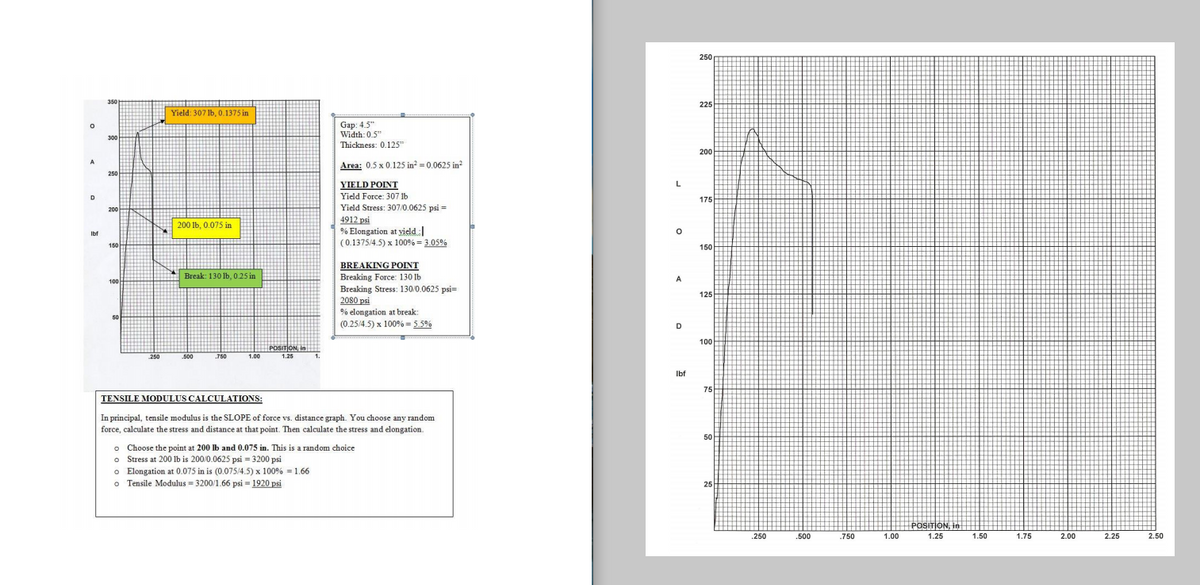4. If the thickness and width of the dog bone for PP are 0.12" and 0.5", respectively, and the initial length is 4.5": a. Calculate the yield point (Ib), yield stress (psi) and elongation at yield b. Calculate the break point (lb), stress at break (psi) c. Calculate elongation at break (%) d. Calculate Modulus of Elasticity (psi)
4. If the thickness and width of the dog bone for PP are 0.12" and 0.5", respectively, and the initial length is 4.5": a. Calculate the yield point (Ib), yield stress (psi) and elongation at yield b. Calculate the break point (lb), stress at break (psi) c. Calculate elongation at break (%) d. Calculate Modulus of Elasticity (psi)
Mechanics of Materials (MindTap Course List)
9th Edition
ISBN:9781337093347
Author:Barry J. Goodno, James M. Gere
Publisher:Barry J. Goodno, James M. Gere
Chapter1: Tension, Compression, And Shear
Section: Chapter Questions
Problem 1.6.5P: An aluminum bar has length L = 6 ft and diameter d = 1.375 in. The stress-strain curse for the...
Related questions
Question

Transcribed Image Text:250
3501
225
Yield: 307 lb, 0.1375 in
Gap: 4.5"
Width: 0.5"
300
Thickness: 0.125"
200
Area: 0.5 x 0.125 in? = 0.0625 in
250
YIELD POINT
L
D
Yield Force: 307 1b
175
Yield Stress: 307/0.0625 psi =
200
4912 psi
% Elongation at vield:
(0.1375/4.5) x 100% = 3.05%
200 lb, 0.075 in
Ibf
150
150
BREAKING POoINT
Break: 130 lb, 0.25 in
Breaking Force: 130 lb
Breaking Stress: 130/0.0625 psi=
2080 psi
A
100
125
% elongation at break
(0.25/4.5) x 100% = 5.5%
50
100
POSITION, in
250
500
.750
1.00
1.25
1.
Ibf
75
TENSILE MODULUS CALCULATIONS:
In principal, tensile modulus is the SLOPE of force vs. distance graph. You choose any random
force, calculate the stress and distance at that point. Then calculate the stress and elongation.
50
o Choose the point at 200 lb and 0.075 in. This is a random choice
•
o Stress at 200 1b is 200/0.0625 psi = 3200 psi
O Elongation at 0.075 in is (0.075/4.5) x 100% = 1.66
o Tensile Modulus = 3200/1.66 psi = 1920 psi
25
POSITION, in
.250
.500
.750
1.00
1.25
1.50
1.75
2.00
2.25
2.50

Transcribed Image Text:4. If the thickness and width of the dog bone for PP are 0.12" and 0.5",
respectively, and the initial length is 4.5":
a. Calculate the yield point (lb), yield stress (psi) and elongation at yield
b. Calculate the break point (lb), stress at break (psi)
c. Calculate elongation at break (%)
d. Calculate Modulus of Elasticity (psi)
Expert Solution
This question has been solved!
Explore an expertly crafted, step-by-step solution for a thorough understanding of key concepts.
This is a popular solution!
Trending now
This is a popular solution!
Step by step
Solved in 5 steps with 5 images

Knowledge Booster
Learn more about
Need a deep-dive on the concept behind this application? Look no further. Learn more about this topic, mechanical-engineering and related others by exploring similar questions and additional content below.Recommended textbooks for you

Mechanics of Materials (MindTap Course List)
Mechanical Engineering
ISBN:
9781337093347
Author:
Barry J. Goodno, James M. Gere
Publisher:
Cengage Learning

Mechanics of Materials (MindTap Course List)
Mechanical Engineering
ISBN:
9781337093347
Author:
Barry J. Goodno, James M. Gere
Publisher:
Cengage Learning